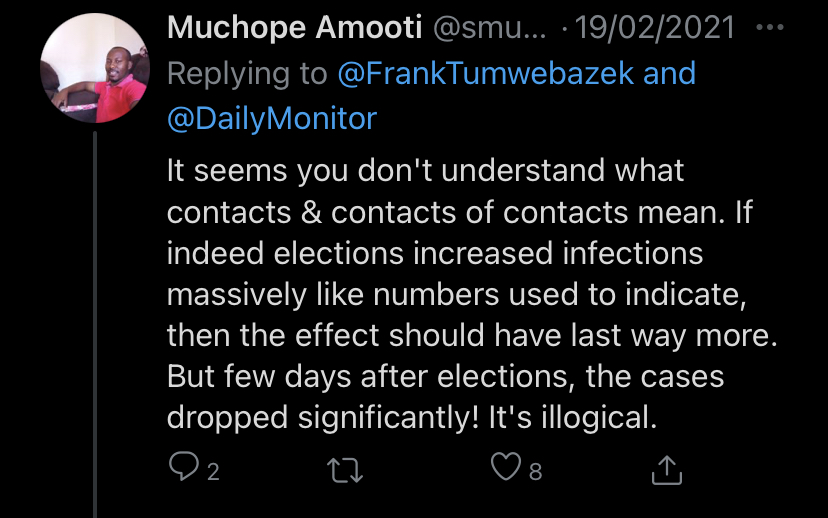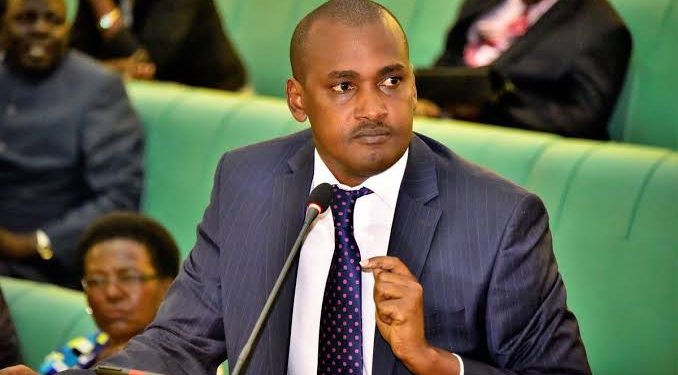By Robert Madoi
Frank Tumwebaze, Uganda’s Gender, Labour and Social Development minister, subtweeted Daily Monitor’s 19 February front page before firing off a strong objection to the content of the newspaper’s lead story. Daily Monitor effectively took a middle-of-the-road position while noting — as its running title indeed screamed — that “Covid cases [have] decline[d] after [the] January polls.”
In response to the story, Tumwebaze tweeted: “To the contrary @DailyMonitor ur (sic) story confirms that poll activities which encouraged violation of #CovidSops led to a spike in covid cases & when the polls ended the vulnerabilities of crowding ended too thus slowing down the wave of transmission. So where then is the puzzle?”

The rhetorical question drew fire from a cross section of Ugandans on Twitter who promptly questioned Tumwebaze’s epidemiological reading of the effect of poll activities on Uganda’s Covid-19 caseload. One of them told the minister thus: “It seems you don’t understand what contacts & contacts of contacts mean. If indeed elections increased infections massively like numbers used to indicate, then the effect should have last (sic) way more (sic). But few days after elections, the cases dropped significantly! It’s illogical.”

The epidemiology is, however, a bit murkier than either side would like to admit. The creeping politicisation of the pandemic has in recent times stuck out like the metaphorical sore thumb. An analysis by Daily Monitor for instance showed that nearly half of the 16 districts the Electoral Commission barred from outrightly electioneering on account of crippling Covid-19 caseloads cumulated less than 400 cases in 10 months.
There is a body of evidence that justifies the categorisation of tried and tested electioneering methods as superspreading events. Stanford researchers for one looked into 18 rallies then US president, Donald Trump staged between June 20, 2020 and September 22, 2020. The researchers found that the rallies ultimately resulted in more than 30,000 confirmed cases of Covid-19. Their findings also note that the rallies “likely led to more than 700 deaths, though not necessarily among attendees.”
More on why this shouldn’t be fodder for Tumwebaze later. The outstanding question for now is: can parallels be drawn with the beach superspreader myth in the United Kingdom? After no outbreaks were linked to the ‘sea of humanity’ that descended on beaches along the Southend coast, a strong narrative about outdoor transmission started to be mainstreamed. It appears that the handful of transmission events that are linked to outdoor activities involve either prolonged close contact or a mixture of indoor and outdoor time.
Like those of beachgoers on England’s south coast in June of 2020, photos of Ugandans attending political rallies suggested prolonged close contact. Research has not been undertaken to tell whether the photos were shot using either a standard or a telephoto lens. The latter’s long focal length produces a flattened perspective where the foreground, mid-ground and background are flattened against each other. This brings subjects closer to each other, giving the impression of close contact. Also hard to tell is whether Robert Kyagulanyi’s rallies melded indoor and outdoor time.
What is clear is that it is unsafe to stand without a mask in close proximity to an infected person who is talking or coughing. While virus-containing droplets emitted when an infected person breaths, speaks or coughs travel beyond two metres, these aerosols in fact quickly dissipate outdoors. The danger is more pronounced indoors where the airborne particles stay afloat in the air for hours.
Our ruling
Tumwebaze tweeted: “To the contrary @DailyMonitor ur (sic) story confirms that poll activities which encouraged violation of #CovidSops led to a spike in covid cases & when the polls ended the vulnerabilities of crowding ended too thus slowing down the wave of transmission. So where then is the puzzle?”
Nothing in Daily Monitor’s story suggests that poll activities led to a spike in Covid-19 cases. If anything, aerosol physics shows that mitigating airborne transmission outdoors does not require the great effort that Tumwebaze laboured to explain. It is also worth noting that Trump’s large outdoor events (call them superspreader rallies) were often either preceded or followed by indoor crowds.
We rate the minister’s tweet Mostly False.
Our sources
Bernheim et al, “The Effects of Large Group Meetings on the Spread of COVID-19: The Case of Trump Rallies,” Dec. 18, 2020
Daily Monitor, “Covid Cases Decline After January Polls,” Feb. 19, 2021
Daily Monitor, “Covid Data Contradicts EC Campaign Freeze Claims,” Dec. 29, 2020
The Guardian, “How the Beach ‘Super-spreader’ Myth can Inform UK’s Future Covid Response,” Feb. 19, 2021
The Lancet, COVID-19 Commission Statement on the Occasion of the 75th Session of the UN General Assembly, Sept. 14, 2020
Twitter post, Feb. 19, 2021
Twitter post, Feb. 19, 2021









